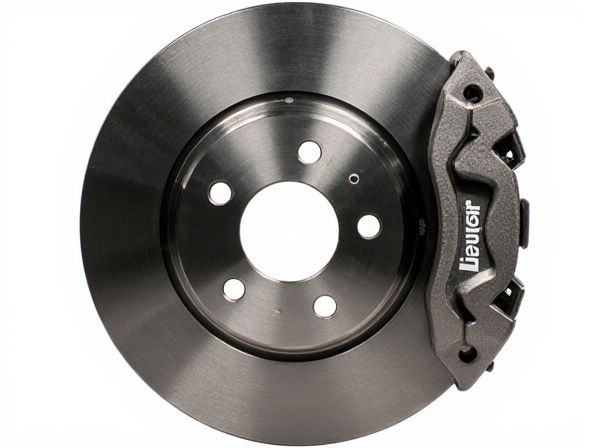
Photo illustration: Two-Piece Rotors vs One-Piece Rotors
Two-piece rotors offer improved heat dissipation and reduced warping compared to one-piece rotors, enhancing brake performance and longevity. They feature a separate braking surface and hub, which allows for replacement of worn components individually, saving money on repairs. You can expect better durability and easier maintenance with two-piece rotors in high-performance or heavy-duty driving conditions.
Table of Comparison
| Feature | Two-Piece Rotors | One-Piece Rotors |
|---|---|---|
| Construction | Separate rotor ring and hub, bolted together | Single solid piece |
| Heat Dissipation | Improved, reduces warping | Less efficient, prone to heat buildup |
| Weight | Lighter due to aluminum hub | Heavier, solid metal |
| Cost | Higher initial cost | More affordable |
| Maintenance | Hub and rotor replaceable separately | Entire rotor replaced when worn |
| Performance | Better for high-performance and racing | Suitable for daily driving |
Introduction to Brake Rotors
Brake rotors are essential components of vehicle braking systems, providing the friction surface needed to slow down or stop the wheels. Two-piece rotors consist of a separate friction disc and hat, often made from lightweight aluminum, offering improved heat dissipation and reduced weight compared to one-piece rotors. One-piece rotors are typically cast as a single unit, delivering durability and affordability but with less thermal efficiency than their two-piece counterparts.
What Are One-Piece Rotors?
One-piece rotors are a type of brake rotor where the braking surface and the hub are manufactured as a single, solid piece of metal, typically cast iron or steel. This design offers simplicity, lower cost, and ease of replacement, making them common in standard passenger vehicles and light-duty trucks. One-piece rotors provide reliable braking performance but tend to dissipate heat less efficiently compared to two-piece rotors, which can affect durability under heavy braking conditions.
What Are Two-Piece Rotors?
Two-piece rotors consist of a separate rotor ring and hub, typically made from different materials to optimize performance and durability. This design improves heat dissipation and reduces weight compared to one-piece rotors, enhancing braking efficiency and minimizing warping under extreme conditions. Commonly used in high-performance and heavy-duty vehicles, two-piece rotors offer easier maintenance and replacement by allowing the rotor ring to be swapped without replacing the entire assembly.
Key Differences Between One-Piece and Two-Piece Rotors
Two-piece rotors feature a separate rotor ring and hub, typically made of cast iron and aluminum respectively, which enhances heat dissipation and reduces weight compared to one-piece rotors made entirely of cast iron. This design improves thermal performance and longevity by allowing the rotor ring to expand independently from the hub, minimizing warping under high-heat conditions. Additionally, two-piece rotors facilitate easier and more cost-effective replacements since only the rotor ring wears out, unlike one-piece rotors that require full rotor replacement.
Performance Advantages of Two-Piece Rotors
Two-piece rotors offer superior thermal management by combining a lightweight aluminum hat with a durable iron friction surface, reducing heat-induced warping and improving braking consistency. This design allows for better expansion control during high-performance driving, resulting in enhanced pedal feel and reduced brake fade. Compared to one-piece rotors, two-piece rotors provide improved weight savings and increased durability, making them ideal for performance-oriented vehicles.
Durability and Longevity Comparison
Two-piece rotors feature a separate braking surface and hub, typically made from cast iron and aluminum, offering enhanced heat dissipation and reduced warping for increased durability compared to traditional one-piece cast iron rotors. The aluminum hat in two-piece rotors minimizes weight and thermal expansion, contributing to longer rotor lifespan and consistent braking performance under extreme conditions. One-piece rotors, while generally more cost-effective, are prone to faster wear and heat-related damage, leading to shorter longevity in high-performance or demanding driving scenarios.
Weight and Heat Dissipation Factors
Two-piece rotors are lighter than one-piece rotors due to their aluminum hats combined with iron braking surfaces, reducing overall unsprung weight and improving vehicle handling. They feature superior heat dissipation as the aluminum hat promotes better thermal conductivity and minimizes heat soak compared to the solid iron construction of one-piece rotors. The design of two-piece rotors allows for expansion and contraction, reducing the risk of warping under extreme braking conditions, which is critical for performance and longevity.
Cost Considerations: Upfront and Long-Term
Two-piece rotors typically have a higher upfront cost due to the intricate design and materials used, but they offer long-term savings through easier and less expensive replacement of the braking surface. One-piece rotors are more budget-friendly initially but may incur higher maintenance costs over time as the entire rotor must be replaced when worn or damaged. Evaluating total cost of ownership involves balancing initial investment with durability and maintenance frequency, making two-piece rotors a cost-effective option for performance-focused or heavy-use vehicles.
Ideal Applications for Each Rotor Type
Two-piece rotors excel in high-performance and heavy-duty applications where thermal expansion and heat dissipation are critical, such as racing or off-road vehicles, due to their ability to handle extreme temperatures and reduce brake fade. One-piece rotors are ideal for everyday driving and standard vehicle use, offering cost-effectiveness and simpler installation while providing reliable performance under typical driving conditions. Selecting the appropriate rotor type depends on vehicle usage intensity, braking demands, and maintenance preferences.
Which Rotor Is Right for You?
Two-piece rotors offer enhanced heat dissipation and reduced warping, making them ideal for high-performance vehicles and heavy-duty driving conditions, whereas one-piece rotors are more cost-effective and simpler to install, suitable for everyday commuting and light use. Considering your driving habits, vehicle type, and budget will help determine the best rotor choice to ensure optimal braking performance and longevity. High-performance drivers and off-road enthusiasts typically benefit from the durability and thermal advantages of two-piece rotors, while casual drivers find one-piece rotors meet their needs efficiently.
 caratoz.com
caratoz.com